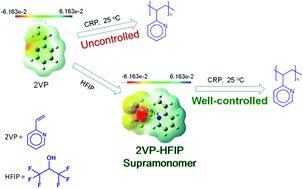Xiulin Zhua
a Jiangsu Key Laboratory of Advanced Functional Polymer Design and Application, Suzhou Key Laboratory of Macromolecular Design and Precision Synthesis, Department of Polymer Science and Engineering, College of Chemistry, Chemical Engineering and Materials Science, Soochow University, Suzhou Industrial Park, Suzhou 215123, China
b School of Chemistry and Materials Science, Ludong University, Yantai 264025, China
Polym. Chem. 2015, 6, 2620-2625
The monomer-activating effect imposed by hydrogen bonding has been long acknowledged, however, an in-depth understanding is still lacking. In this work, for the first time, the monomer-activating effect was elucidated with 2-vinyl pyridine (2VP) as the model monomer and 1,1,1,3,3,3-hexafluoro-2-propanol (HFIP) as the hydrogen bonding donor (solvent). Strong hydrogen bonding between HFIP and 2VP was revealed by careful 1H NMR analysis and computer simulations. Upon this solid hydrogen bonding, 2VP underwent a well-controlled radical polymerization with improved control over the molecular weight in contrast to those under a non-hydrogen bonding environment. The well-controlled manner of the polymerization was ascribed to the electron induction effect of monomer molecules under hydrogen bonding interactions, i.e., the electron redistribution of the monomer's vinyl double bonds, activating the monomers. The hydrogen bonding interactions between HFIP and growing radicals or HFIP and the terminal monomer units of dormant polymeric species might also contribute to the good control. The unprecedented explanation of hydrogen bonding promoting controlled radical polymerization or a monomer-activating effect was testified for other monomers, and some reasonable discussion was made.

链接:
//pubs.rsc.org/en/Content/ArticleLanding/2015/PY/c5py00046g#!divAbstract